
Driving Growth with SaaS Social Media Marketing: A Comprehensive Guide
In today’s digital landscape, social media has become an indispensable tool for businesses looking to expand their reach and engage with their target audience. For SaaS companies, leveraging social media marketing strategies can be particularly impactful in driving brand awareness, fostering customer relationships, and, ultimately, driving growth. In this guide, we’ll delve into the SaaS social media marketing world, exploring effective tactics and best practices to maximize your online presence and propel your business forward. Whether you’re just starting or looking to refine your existing strategies, this comprehensive resource will equip you with the knowledge and insights needed to succeed in the competitive SaaS market.
Why Use Social Media Marketing in B2B SaaS?
There are several compelling reasons why B2B SaaS companies should invest in social media marketing:
Reach Your Target Audience:
Social media platforms offer a powerful means to connect directly with the specific individuals or groups you aim to reach. Whether they’re key decision-makers, influencers, or end-users within your industry, you can tailor your messaging and engagement strategies to resonate with them. This direct connection enables you to understand their needs, preferences, and pain points more intimately, facilitating more effective communication and relationship-building.
Build Brand Awareness:
Consistency is key to building brand awareness on social media. Regularly sharing valuable content showcasing your expertise, insights, and unique offerings can position your SaaS brand as a trusted authority within your niche. Over time, this establishes credibility and fosters recognition among your target audience, increasing the likelihood that they’ll turn to you when seeking solutions or insights relevant to your industry.
Drive Website Traffic and Leads:
Social media is a potent channel for driving traffic to your website and converting visitors into leads. Strategic content promotion, such as gated content offers, product demos, or free trials, can attract attention to your site’s valuable resources. By enticing users with compelling calls to action and clear value propositions, you can encourage them to take the next step in their buyer’s journey, whether downloading an ebook, signing up for a webinar, or requesting a demo.
Engage with Customers:
Social media’s most significant advantage is its ability to facilitate real customer engagement. By actively monitoring your social channels and promptly responding to inquiries, feedback, and comments, you demonstrate a commitment to customer satisfaction and foster a sense of community around your brand. This open line of communication helps address concerns and resolve issues promptly. It provides valuable insights into customer sentiment, preferences, and pain points, which can inform future product development and marketing strategies.
Getting Started with SaaS Social Media Marketing
To get started with social media marketing for your SaaS business, you’ll need to:
Define Your Target Audience:
Start by clearly defining your ideal customers. Consider demographics such as age, gender, location, and income level, and psychographics like interests, values, and behaviors. Identify their job roles, industries, and the specific pain points or challenges they face that your SaaS product can address.
Choose the Right Platforms:
Research which social media platforms your target audience frequents the most. For example, if you’re targeting B2B professionals, LinkedIn might be the most suitable platform. Twitter or Reddit could be more appropriate if your audience consists of tech enthusiasts. Understand where your audience spends time online and focus your efforts on those platforms.
Create a Content Strategy:
Develop a content calendar outlining what content you’ll create and share on social media. Consider a mix of educational content to showcase your expertise, entertaining content to engage your audience, and promotional content to highlight your SaaS product’s benefits. Tailor your content to each platform’s audience and post best practices.
Optimize Your Profiles:
Ensure your social media profiles accurately reflect your SaaS brand. Use high-quality visuals, such as a professional logo and cover photo, and write compelling descriptions that convey your brand’s value proposition. Include relevant keywords in your profiles to improve discoverability in search results.
Allocate Resources:
Assign dedicated resources, whether staff members or a budget for outsourcing, to effectively manage your social media presence. Consistency is key, so ensure you have the resources to consistently create, publish, and engage with your audience on social media platforms.
How to Get Started with SaaS Social Media Marketing
Once you have a solid foundation, you can implement your SaaS social media marketing strategy. Here are some key tactics to consider:
Content Creation:
Consistently producing high-quality content across various formats, such as blog posts, infographics, videos, and case studies, is crucial for engaging your audience and providing value. You can establish yourself as a trusted resource in your industry by addressing their pain points, answering their questions, and offering solutions.
Social Media Advertising:
Paid advertising on platforms like LinkedIn and Twitter can help you reach a broader and more targeted audience. You can increase brand visibility, generate leads, and drive conversions by strategically promoting your content and offerings.
Influencer Marketing:
Collaborating with influencers with a significant following and influence in your industry can help you tap into their audience and gain credibility. Choose influencers whose values align with your brand and work together on campaigns or content collaborations to reach a wider audience and build trust.
Employee Advocacy:
Encouraging your employees to be brand advocates by sharing company updates, content, and thought leadership on their social media profiles can amplify your reach and humanize your brand. Provide them with the necessary resources and guidelines to represent the company accurately and authentically.
Social Listening and Engagement:
Monitoring social media conversations related to your industry, competitors, and brand allows you to gain valuable insights into your audience’s preferences, pain points, and sentiment. Engage with your audience by promptly responding to comments, questions, and mentions, demonstrating your commitment to customer satisfaction and building meaningful relationships.
Analytics and Optimization:
Regularly tracking and analyzing key metrics such as website traffic, lead generation, and engagement rates enables you to measure the effectiveness of your social media efforts. Use these insights to refine your strategy, optimize your content, and maximize your ROI.
Understanding Paid Campaigns vs. Organic Social Content
There are two main approaches to social media marketing: paid campaigns and organic content. Understanding the benefits and limitations of each is essential to creating an effective overall strategy.
Benefits of Organic Social Media
Organic social media content refers to the posts, updates, and interactions you publish on your company’s social media profiles without paying for promotion or advertising. The key benefits of organic social media include:
Building Genuine Connections:
Organic social media enables direct engagement with your audience, fostering authentic relationships and trust. You can position your SaaS brand as a trusted authority in your industry by interacting with your followers, responding to their comments, and sharing valuable content.
Cost-Effective Reach:
Although organic reach has declined on many platforms due to algorithm changes, it still provides a cost-effective way to connect with your audience. By sharing content organically, you can reach your existing followers without incurring additional advertising costs. Moreover, when your content resonates with your audience, they may share it with their networks, further expanding your reach at no extra cost.
Improved SEO:
Search engines like Google consider social signals such as shares, mentions, and links as content relevance and authority indicators. Therefore, consistently publishing high-quality organic social media content can positively impact your SEO efforts by increasing your online visibility and driving traffic to your website.
Long-Term Brand Building:
Consistent, high-quality organic social media content is vital in the long-term brand. Still, you can build a strong reputation and authority in your industry by showcasing your expertise, sharing valuable insights, and demonstrating your company’s industry. This, in turn, leads to increased customer loyalty, advocacy, and brand recognition.
Benefits of Paid Social Media
Paid social media campaigns involve using the advertising platforms provided by social networks to promote your content, offers, or products to a targeted audience. The key benefits of paid social media include:
Increased Reach and Visibility:
By leveraging paid advertising, you can amplify your reach beyond your existing followers and get your content and messaging in front of a highly targeted, relevant audience.
Precise Audience Targeting:
Social media advertising platforms offer advanced targeting options based on demographics, interests, behaviors, and custom audience lists, allowing you to laser-focus your campaigns.
Measurable Results:
Paid social media campaigns provide detailed analytics and reporting, enabling you to track metrics like impressions, clicks, conversions, and return on ad spend (ROAS). This makes it easier to optimize and measure the success of your efforts.
Support Specific Marketing Objectives:
Paid campaigns can be tailored to support various marketing goals, such as generating leads, driving website traffic, increasing app installs, or boosting engagement with your content.
How to Build a Winning Social Media Strategy
To achieve success with social media marketing for your SaaS business, you’ll need to develop a comprehensive social media strategy that aligns with your overall marketing goals and objectives. Here are some key elements to consider:
Set Clear Goals and KPIs:
Define specific, measurable goals for your social media efforts, such as increasing brand awareness, generating leads, or driving customer engagement. Establish key performance indicators (KPIs) to track and measure your progress.
Develop a Content Plan:
Create a detailed content plan that outlines the types of content you’ll create (e.g., blog posts, videos, infographics), the topics and themes you’ll cover, and a consistent publishing schedule.
Integrate with Other Marketing Channels:
Ensure your social media activities are integrated with your other marketing channels, such as email marketing, content marketing, and paid advertising, to create a cohesive and consistent brand experience.
Allocate Sufficient Resources:
Dedicate the necessary resources, including time, budget, and personnel, to execute your social media strategy effectively. If needed, consider outsourcing or hiring dedicated social media professionals.
Continuously Monitor and Optimize:
Regularly analyze your social media performance data, gather audience feedback, and adjust your strategy and tactics to optimize for better results.
Pre-Launch and Post-Launch Effects of SaaS Social Media Marketing
Social media marketing can play a crucial role both before and after the launch of your SaaS product or service. Here’s how it can impact your efforts:
Pre-Launch Effects
Building Anticipation and Buzz:
You can create excitement and generate buzz around your upcoming SaaS launch by sharing teasers, behind-the-scenes content, and sneak peeks on social media.
Audience Research and Validation:
Social media can provide valuable insights into your target audience’s interests, pain points, and preferences, helping you validate and refine your product or service before launch.
Early Adopter Engagement:
Engaging with potential early adopters and industry influencers on social media can help you build relationships and cultivate a community around your SaaS offering.
Post-Launch Effects
Driving Awareness and Acquisition:
After launch, social media can be a powerful channel for promoting your SaaS product or service, driving website traffic, and acquiring new customers.
Customer Support and Engagement:
Social direct communication with your customers enables you to address their questions, concerns, and feedback and fosters long-term engagement and loyalty.
Continuous Product Feedback and Improvement:
By monitoring social media conversations and actively soliciting customer feedback, you can gain valuable insights to inform product updates, new features, and improvements.
Advocacy and Referrals:
Satisfied customers can become powerful advocates for your SaaS brand, sharing their positive experiences and recommendations on social media. This could lead to new customer acquisition through word-of-mouth and referrals.
Top Tools for SaaS Social Media Marketing
Here is the list of Top Tools For SaaS Social Media Marketing.
Hootsuite
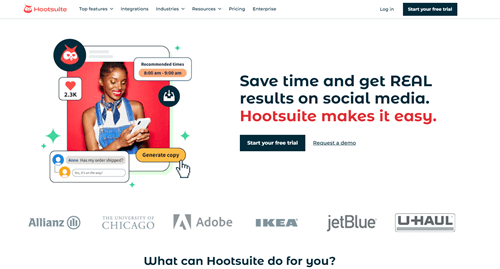
Usefulness:
Hootsuite allows you to schedule posts across multiple social media platforms, monitor mentions, and analyze social media performance.
Benefits:
Streamlines social media management, saves time with scheduling, and provides analytics for informed decision-making.
Limitations:
Some advanced features may require a paid subscription and limited functionality for certain platforms.
Paid or Free:
Offers both free and paid plans with varying features and limitations.
Buffer

Usefulness:
Buffer simplifies social media scheduling, offers analytics, and allows team collaboration.
Benefits:
Easy-to-use interface, scheduling for multiple platforms, analytics for performance tracking.
Limitations:
The free version has limited features and lacks advanced social listening capabilities.
Paid or Free:
Offers both free and paid plans with additional features in the paid version.
Sprout Social
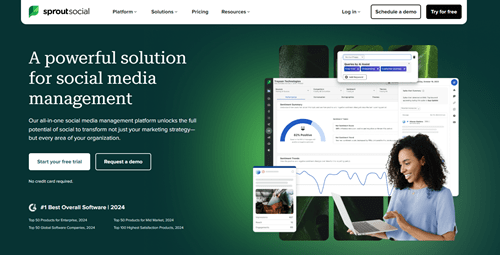
Usefulness:
Sprout Social provides social media management, analytics, and customer engagement tools.
Benefits:
Robust analytics, social listening features, and collaboration tools for teams.
Limitations:
Higher pricing, compared to other tools, may be overwhelming for beginners.
Paid or Free:
We paid subscription models with different tiers based on features and user count.
SocialPilot
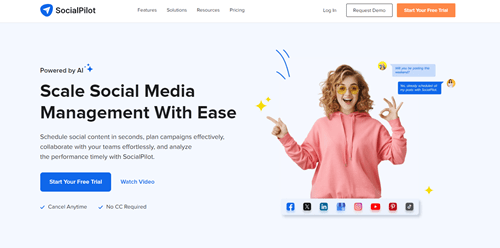
Usefulness:
SocialPilot offers social media scheduling, analytics, and client management for agencies.
Benefits:
Affordable pricing, white-labeling options, and bulk scheduling features.
Limitations:
The interface can be clunky; some lower-tier plans have limited features.
Paid or Free:
Offers both free and paid plans, with additional features in paid plans.
CoSchedule
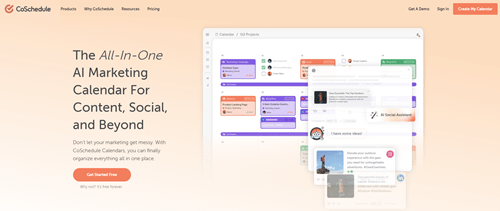
Usefulness:
CoSchedule combines social media scheduling with content marketing and project management features.
Benefits:
Integrated editorial calendar, social media automation, and collaboration tools.
Limitations:
Higher pricing for advanced features may cause a learning curve for new users.
Paid or Free:
We paid subscription models with different plans based on features and user count.
MeetEdgar
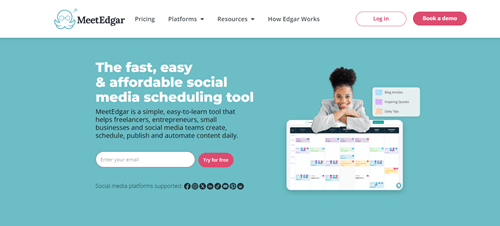
Usefulness:
MeetEdgar specializes in evergreen content scheduling and recycling on social media.
Benefits:
Automates content recycling and categorizes posts for easy management.
Limitations:
They are limited to certain social media platforms with higher pricing for small businesses.
Paid or Free:
Paid subscription model with a monthly fee.
FAQs
How much should I budget for paid social media advertising?
The amount you should budget for paid social media advertising will vary based on your goals, audience size, and industry. Generally, experts recommend allocating between 15-25% of your overall marketing budget to paid social media campaigns.
How often should I post content on social media?
There’s no one-size-fits-all answer, as the ideal posting frequency will depend on your audience, your platforms, and the types of content you’re sharing. However, most experts recommend posting at least once daily on platforms like Twitter and LinkedIn and 3-7 times weekly on Facebook.
How can I measure the success of my SaaS social media efforts?
Key metrics to track include website traffic from social media, lead generation, engagement rates (likes, comments, shares), follower gr convey, versions, and revenue generated. Use analytics tools provided by each platform, as well as Google Analytics, to monitor your performance.
How do I create shareable, engaging content for social media?
Focus on creating a mix of educational, entertaining, and visually appealing content that provides value to your target audience. Use a variety of content formats (e.g., blog posts, videos, infographics) and leverage trending topics, industry news, and user-generated content to stay relevant and engaging.
How can I encourage employee advocacy on social media?
Develop clear social media guidelines and train your employees to effectively and compliantly share company content and updates on their profiles. Consider implementing an employee advocacy program or using tools to streamline the process of sharing approved content.
Conclusion
Social media marketing is a crucial component of any successful SaaS growth strategy. Following the guidance outlined in this comprehensive guide, you can effectively leverage social media platforms to reach and engage your target audience, build brand awareness, generate leads, and drive growth for your B2B SaaS business.
Remember, social media marketing is an ongoing endeavor that requires consistent effort, strategic planning, and continuous optimization. To maximize your results, stay committed to creating high-quality content, engaging with your audience, and embedding organic and paid social media tactics.
With the right approach and dedication, social media can become a powerful marketing channel that helps you achieve your SaaS business goals and stand out in a crowded market.




